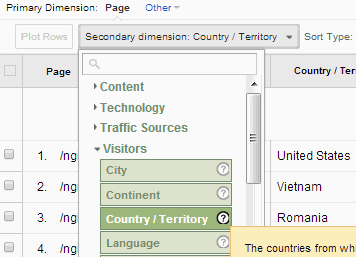Mastering Secondary Dimension in Google Analytics: A Complete Guide
Mastering Secondary Dimension in Google Analytics: A Complete Guide
Blog Article
Transform Your Analytics Method With Second Measurement in Google Analytics
By incorporating additional dimensions right into information evaluation, a new layer of insights arises, dropping light on elaborate user behaviors and communications. The strategic application of secondary measurements holds the crucial to unlocking a prize chest of very useful info that can change just how companies act and translate upon their data.
Recognizing Secondary Measurements in Google Analytics
Secondary measurements in Google Analytics offer added context to main data by permitting individuals to assess metrics across a 2nd measurement, providing much deeper insights right into user actions and interactions on an internet site. Secondary Dimension in Google Analytics. While main measurements offer basic data factors such as pageviews, bounce price, and session duration, second dimensions supply a more comprehensive sight by segmenting the primary data better. This segmentation enables customers to evaluate metrics in combination with one more measurement, such as traffic sources, demographics, or individual actions
Advantages of Using Additional Measurements
Making use of secondary dimensions in Google Analytics uses a strategic advantage by improving the deepness of evaluation and offering an extra extensive understanding of individual communications and actions on a web site. By including secondary dimensions, experts can obtain valuable insights into the performance of certain sections or variables within their information. This makes it possible for a more comprehensive assessment of individual habits beyond surface-level metrics, enabling a deeper exploration of the aspects affecting individual interaction and conversions.

Just How to Execute Additional Dimensions
When incorporating second dimensions in Google Analytics, one important action is to select the pertinent metrics and dimensions to enrich the analysis process. To apply additional measurements properly, start by accessing your Google Analytics account and browsing to the report you wish to enhance with added information. As soon as in the report, situate the "Additional Measurement" switch, typically located above the data table. Clicking this switch will open a drop-down food selection listing numerous dimensions that can be contributed to your key dimension for deeper understandings.
After choosing the ideal secondary dimension, such as 'Source/Medium' or 'Gadget Classification,' Google Analytics will certainly present the data in a much more detailed format, enabling you to cross-analyze various facets of user behavior. Keep in mind to trying out different mixes of second and primary dimensions to uncover valuable patterns and trends that can educate your advertising and marketing techniques. By carrying out additional dimensions thoughtfully, you can acquire a more extensive understanding of your site or app performance and make data-driven decisions to maximize your electronic existence.
Studying Data With Secondary Dimensions
Enhance your information analysis in Google Analytics by incorporating second dimensions to dive deeper right into individual behavior patterns and maximize your digital advertising methods efficiently - Secondary Dimension in Google Analytics. By adding additional dimensions to your primary information, you can get important insights that can help you make informed choices regarding your site or app efficiency
Examining data with secondary measurements enables you to section page your key information better, supplying Get More Info a much more extensive sight of individual communications. For example, integrating the primary dimension of 'source/medium' with an additional measurement like 'landing web page' can reveal which details pages are driving website traffic from different resources. This details can be important in improving your material technique or maximizing your marketing campaign to increase conversions.
In addition, utilizing additional measurements enables you to identify correlations in between different metrics, helping you comprehend the influence of various elements on individual habits. Whether it's analyzing demographics alongside individual interaction metrics or gadget classifications with conversion prices, second measurements encourage you to reveal surprise trends and patterns that can direct your advertising initiatives.
Maximizing Efficiency With Second Measurements
To boost the performance of information evaluation and decision-making in Google Analytics, including second dimensions is vital to maximizing efficiency metrics and gaining much deeper understandings right into individual habits patterns. By using secondary dimensions, analysts can dive past surface-level data and uncover valuable correlations that might or else go undetected. This optimization technique enables businesses to customize their advertising efforts more properly, recognize areas for improvement in website use, and boost general customer experience.
Second dimensions offer a more detailed view of customer interactions by providing added context to main information metrics. Combining the main measurement of 'touchdown web page' with a secondary measurement like 'device group' can expose whether particular gadgets are much more likely to drive involvement on particular touchdown pages. This insight can educate responsive style renovations or targeted marketing strategies to improve efficiency.

Conclusion
In final thought, the integration of second dimensions in Google Analytics provides services with a powerful tool to boost their analytics method. Secondary Dimension in Google Analytics. By diving deeper into individual actions and interactions, marketing professionals can uncover important understandings that original site can drive efficiency optimization and improve the general customer experience. Leveraging secondary dimensions permits for a more extensive evaluation of information, leading to more educated decision-making and customized marketing efforts
Additional measurements in Google Analytics provide extra context to main information by permitting users to evaluate metrics across a 2nd measurement, supplying deeper insights into individual actions and interactions on a site. While primary dimensions provide essential data points such as pageviews, bounce rate, and session duration, additional dimensions provide a more in-depth view by segmenting the primary data further.One of the essential benefits of using secondary dimensions is the ability to uncover relationships and patterns that might not be immediately obvious when evaluating data with primary dimensions alone.When including second measurements in Google Analytics, one crucial action is to choose the appropriate metrics and dimensions to improve the evaluation process. Coupling the key measurement of 'landing page' with a second measurement like 'device category' can disclose whether specific devices are more most likely to drive interaction on details touchdown pages.
Report this page